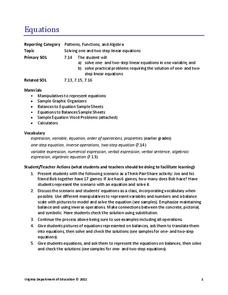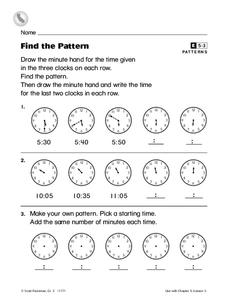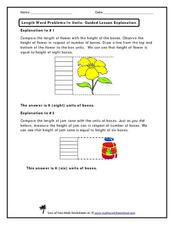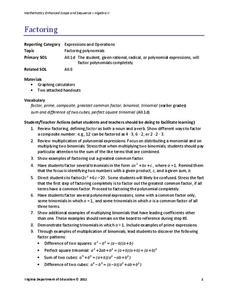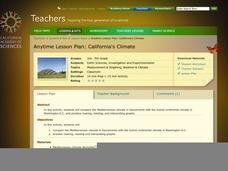Concord Consortium
Here Comes the Sun
Many phenomena in life are periodic in nature. A task-based lesson asks scholars to explore one of these phenomena. They collect data showing the sunrise time of a specific location over the period of a year. Using the data, they create...
Curated OER
Ten More or Ten Less
Adding and subtracting 10 is easy once you understand the tricks! Learners first write numbers that are ten more than two double-digit numbers. Then, they find numbers ten less than two other double-digit numbers. An explanation on the...
Northern Arizona University
Adding and Subtracting Fractions
Pattern blocks and shapes demonstrate how to add and subtract fractions. By aligning blocks with different shapes, learners figure out how to create a whole, and then how to add and delete parts from that whole.
Willow Tree
Fibonacci and Other Sequences
Fibonacci is an interesting sequence that forms some unique patterns. Learners explore sequences that do not have the typical arithmetic and geometric patterns. They identify the pattern and find the next consecutive terms....
University of Utah
Representations of a Line
Line up to learn about lines! Scholars discover how to express patterns as linear functions. The workbook then covers how to graph and write linear equations in slope-intercept form, as well as how to write equations of parallel and...
Willow Tree
Scatterplots and Stem-and-Leaf Plots
Is there a correlation between the number of cats you own and your age? Use a scatter plot to analyze these correlation questions. Learners plot data and look for positive, negative, or no correlation, then create stem-and-leaf plots to...
Curated OER
My Foot and the Standard Foot
Young mathematicians put one foot in front of the other as they learn how to measure length in an elementary math lesson. Using paper cutouts of their own feet, children measure classroom objects as they discover the importance of...
Math Mammoth
Grade 1 Worktext
Use graphing, counting, and number lines to help first graders learn about addition and subtraction. An array of worksheets and activities are an excellent resource for your math lesson, whether you are focusing on counting skills or...
Curated OER
Pascal's Triangle
In this math worksheet, students read the discussion about the importance of games. They create a game as directed. They also read the rules for the Pascal Triangle.
Virginia Department of Education
Equations
Science equipment can be handy for math class, too. Scholars learn to solve one- and two-step linear equations by using the concept of a balance. They solve real-world problems in a variety of contexts by writing and solving linear...
Curated OER
Counting Forward
Practice counting on from a number using these three sequence starters. Arranged in order of increasing difficulty, the first sequence begins at 5 and has learners add 9 numbers. The answers are written below each sequence, so they...
Curated OER
Find the Pattern
In this clock patterns worksheet, 2nd graders draw the minute hand for the time given in the three clocks on each row of clocks. Students find the pattern and then draw the minute hand on the last two clocks in each row. Students make...
Curated OER
Finding Patterns
In this finding patterns activity, students analyze the 6 numbers in a box. Students put an X on the number that does not belong and write the others in a pattern. There are 4 questions on the page.
Curated OER
Patterns With 10
In this patterns worksheet, 1st graders add as many circles as needed to make 10 circles in 9 rows. Students write a number sentence for each row in exercise 10.
Curated OER
Three-Digit Patterns
Second graders complete patterns. In this basic problem solving worksheet, 2nd graders continue 6 number patterns. This would be a perfect homework assignment after a lesson on number patterns.
Curated OER
Adding and Subtracting Up to 5 Guided Lesson Explanation
A teacher resource, this scripted lesson details how learners can solve addition and subtraction problems involving numbers up to five. The referenced pupil instructional activity is not included.
Curated OER
Length World Problems in Units - Guided Lesson Explanation
Rather than a worksheet, this teacher resource is a one-page, scripted answer sheet for a guided lesson on length word problems. First graders are asked to compare the length of a flower and a jar of jam with a number of unit boxes....
EngageNY
Analyzing Residuals (Part 2)
Learn about patterns in residual plots with an informative math activity. Two examples make connections between the appearance of a residual plot and whether a linear model is the best model apparent. The problem set and exit ticket...
EngageNY
Exponents
Powered up! Here's a great resource on exponents. Scholars build on their previous understanding of exponents to include all positive real number bases. Distinguishing between an and a^n is a major goal in the fifth activity of a 36-part...
West Contra Costa Unified School District
Writing Exponential Functions Based on Data
Give your class a concrete example of exponential growth and decay using this hands-on activity. These Algebra II lessons allow for the exploration of exponential growth and decay models, as well as the discovery of the patterns of each....
EngageNY
Analyzing Residuals (Part 1)
Just how far off is the least squares line? Using a graphing calculator, individuals or pairs create residual plots in order to determine how well a best fit line models data. Three examples walk through the calculator procedure of...
EngageNY
Mid-Module Assessment Task: Grade 8 Module 6
Make sure pupils have the skills to move on to the second half of the module with a mid-module assessment task. The formative assessment instrument checks student learning before moving on to the rest of the lessons in the unit.
Virginia Department of Education
Factoring
Uncover the relationship between factoring quadratics and higher degree polynomials. Learners develop their factoring skills through repetition. A comprehensive instructional activity begins with quadratics and shows how to use the same...
California Academy of Science
California's Climate
The United States is a large country with many different climates. Graph and analyze temperature and rainfall data for Sacramento and Washington DC as you teach your class about the characteristics of Mediterranean climates. Discuss the...











